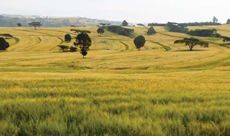Boom Or Doom!
 Future Of Cereal Farming In Narok
Future Of Cereal Farming In Narok
Over the years, patterns of land use have changed in the ASAL from principally, nomadic pastoralism to sedentary pastoral and agro pastoral production, or to pure cultivation. Vast areas of those lands are experiencing some degree of unprecedented population growth, excessive cropping pressure and overgrazing.
Overgrazing followed by mono-cropping for the last 30 years has caused a negative impact on vegetation resources and biodiversity. The productivity, carrying capacity and soil fertility in this case have adversely been affected and in extreme cases leading to desertification.
Recent interventions such as land privatization and appropriation, to create ranching schemes or to give room to cropping have not been successful.
Cereals including wheat, barley and Maize have been grown in Narok for the last 30 years during which farming has gone through a lot of technology revolution to keep this farming going.
New seed varieties of the above cereal crops have been developed to adapt to the climatic conditions of the area ensuring good productivity. Agrochemical companies have also invested millions of Dollars in research, registration, development and launching of agro-chemicals that can assist the farmers in the control of weeds, diseases and Insects; more so protect their yields.
Farmers on their side have put all they have into the programs to ensure the timing is just right so they don’t miss out on the rainy season. Over the years, challenges have emerged due to changing weather patterns and deterioration of soil due to overgrazing and mono-cropping. This has led to unsustainable productivity hence leading to low returns for the farmers and forcing farmers to abandon cereal farming or to reduce land acreage and/or push to adapt or invest on new technologies that can help them cope with the challenges for a while which has come with a huge cost .
Over these years the cost of production has increased drastically and the opposite has happened to the production of the crops per acre leading to unsustainable Return on Investment (ROI).
However, the land tenure system in Narok land which is a one season leasing concept hasn’t made it easier for farmers to have an option of investing on improving the soil fertility. Soil fertility is key to sustainable productivity and requires a long time investment to build and improve. The short term lease period system has led to mono cropping as the farmers try to maximize with one season so as to get good returns. There is no room for crop rotation, liming or organic matter build up.
With low soil fertility it has seen farmer increasing the rate of inputs including fertilizers over the years to achieve same yields or sometime even lower yield than expected.
Narok area usually receives an annual rainfall of 600-1000mm, which would be enough to grow a good crop. The biggest challenge has been change of weather patterns especially when the rains come off season .This unpredictable rainfall pattern has brought a lot of uncertainty to the farmers calendar and planning of farming programs has become difficult .
With the unstable economic situation in Kenya currently the cost of credit both from the financial institutions and chemical companies is becoming too high for the farmer to bear and for stakeholders to support. A major revolution is needed to ensure the future of cereal farming is secured. Policies to change the Land tenure system to a long lease along with establishment of ranching systems or grazing fallows can help farmers long term investment into soil fertility improvement through right farming practices. Planting of trees is another project that the county government of Narok should start to create more forest cover hence help alleviate the effects of climate change.
By Doris Kawira